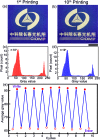Rewritable Painting Realized from Ambient-Sensitive Fluorescence of ZnO Nanoparticles
- PMID: 28169344
- PMCID: PMC5294571
- DOI: 10.1038/srep42232
Rewritable Painting Realized from Ambient-Sensitive Fluorescence of ZnO Nanoparticles
Abstract
Paper, as one of the most important information carriers, has contributed to the development and transmission of human civilization greatly. Meanwhile, a serious problem of environmental sustainable development caused by the production and utilization of paper has been resulted to modern society. Therefore, a simple and green route is urgently demanded to realize rewritable painting on paper. Herein, a simple route to rewritable painting on copy paper has been demonstrated by using eco-friendly ZnO nanoparticles (NPs) as fluorescent ink, and vinegar and soda that are frequently used in kitchen as erasing and neutralizing agents. Words or patterns written using the ZnO NPs as ink can be erased by vinegar vapour within five seconds, and after a neutralizing process in the ambient of soda vapour, the paper can be used for writing again. It is worth noting that the resolution and precision of the patterns produced via the above route degrade little after ten rewriting cycles, and the quality of the patterns produced using the ZnO NPs as ink fades little after being storage for several months, which promises the versatile potential applications of the rewriting route proposed in this paper.
Conflict of interest statement
The authors declare no competing financial interests.
Figures







Similar articles
-
Multi-Colored Aqueous Ink for Rewritable Paper.Small. 2024 Oct;20(42):e2403512. doi: 10.1002/smll.202403512. Epub 2024 Jul 16. Small. 2024. PMID: 39011973
-
Photocatalytic colour switching of redox dyes for ink-free light-printable rewritable paper.Nat Commun. 2014 Dec 2;5:5459. doi: 10.1038/ncomms6459. Nat Commun. 2014. PMID: 25463000
-
Hydrochromic molecular switches for water-jet rewritable paper.Nat Commun. 2014;5:3044. doi: 10.1038/ncomms4044. Nat Commun. 2014. PMID: 24472877
-
A review on biogenic synthesis of ZnO nanoparticles using plant extracts and microbes: A prospect towards green chemistry.J Photochem Photobiol B. 2017 Jan;166:272-284. doi: 10.1016/j.jphotobiol.2016.12.011. Epub 2016 Dec 18. J Photochem Photobiol B. 2017. PMID: 28013182 Review.
-
Biotechnological aspects of ZnO nanoparticles: overview on synthesis and its applications.Appl Microbiol Biotechnol. 2016 Jan;100(2):571-81. doi: 10.1007/s00253-015-7108-x. Epub 2015 Nov 6. Appl Microbiol Biotechnol. 2016. PMID: 26541334 Review.
Cited by
-
ZnO-Salen NPs Employed as Chemosensor for Detection of Al3+ and K+ in Aqueous Medium, Developing Human Cell Images.J Fluoresc. 2025 Jul;35(7):5319-5331. doi: 10.1007/s10895-024-03913-4. Epub 2024 Aug 31. J Fluoresc. 2025. PMID: 39215912 Free PMC article.
-
Dose-Dependent Effect of ZnO Quantum Dots for Lettuce Growth.ACS Omega. 2021 Apr 11;6(15):10141-10149. doi: 10.1021/acsomega.1c00205. eCollection 2021 Apr 20. ACS Omega. 2021. PMID: 34056168 Free PMC article.
-
Synthesis and performance of ZnO quantum dots water-based fluorescent ink for anti-counterfeiting applications.Sci Rep. 2021 Mar 12;11(1):5841. doi: 10.1038/s41598-021-85468-z. Sci Rep. 2021. PMID: 33712692 Free PMC article.
References
-
- White paper: Environmental issues associated with toner and ink Usage (Preton Ltd., 2010).
-
- Hermy M., Honnay O., Firbank L., Grashof-Bokdam C. & Lawesson J. E. An ecological comparison between ancient and other forest plant species of Europe, and the implications for forest conservation. Biol. Cons. 91, 9–22 (1999).
-
- Zhang J., Zou Q. & Tian H. Photochromic materials: more than meets the eye. Adv. Mater. 25, 378–399 (2013). - PubMed
-
- Li Y., Urbas A. & Li Q. Reversible light-directed red, green, and blue reflection with thermal stability enabled by a self-organized helical superstructure. J. Am. Chem. Soc. 134, 9573–9576 (2012). - PubMed
Publication types
LinkOut - more resources
Full Text Sources
Other Literature Sources

